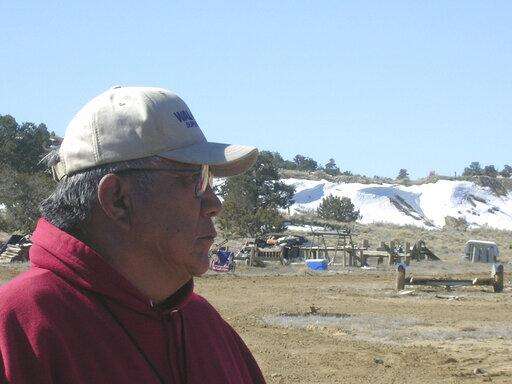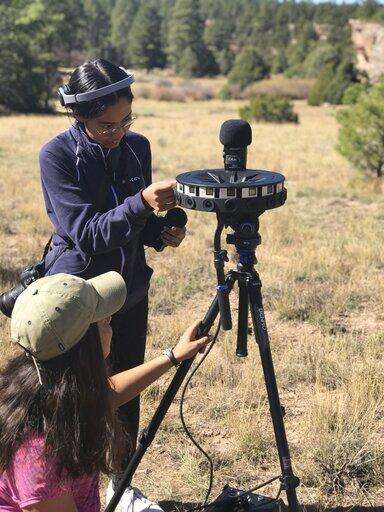In this Sept. 6, 2019, photo provided by Ways of Knowing, audience members try out virtual reality headsets to watch "Ways of Knowing" a film titled "Ways of Knowing," which was directed by artist Kayla Briet, at the El Morro Events Center in Gallup, N.M. Briet and other activists were using virtual reality technology like a 360 VR video rig cameras to focus on areas of the Navajo Nation affected by uranium contamination. (Adriel Luis/Ways of Knowing via AP)
The Associated Press
GALLUP, N.M. (AP) - Activists are using virtual reality technology to focus on areas of the Navajo Nation affected by uranium contamination.
The arts collective Bombshelltoe has collected 360-degree footage of land near Churchrock, New Mexico, to show how people and the land have changed since a 1979 uranium mill spill, the Gallup Independent reports .
The film, titled "Ways of Knowing," was directed by artist Kayla Briet.
The project started four years ago after Washington, D.C.-based nuclear policy program manager Lovely Umayam met Navajo activist Sunny Dooley at an event in Santa Fe, New Mexico. Filmmaker Adriel Luis is also a co-producer of the movie.
"Sunny asked us during this meeting, 'Where is your heart?' And it caught my - along with everyone else's - attention," Umayam said.
In 1979, a dam on the Navajo Nation near Church Rock broke at a uranium mill's evaporation pond, releasing 94 million gallons (356 million liters) of radioactive waste into the Puerco River.
It was the largest accidental release of radioactive material in United States history and three times the radiation released at the Three Mile Island accident.
The radiation contaminated not only water but the food chain. Cattle in western New Mexico later showed higher levels of radiation.
Dooley, who lives in Chi Chil Tah, New Mexico, said she has felt the direct effects of the big spill that went down the Rio Puerco and contaminated the water and soil in her community.
During a recent presentation of the virtual reality footage, Dooley talked about her daily life of not being able to have running water in her home because it is contaminated. "I have to come to Gallup to get my water and take it back home," she said.
Umayam said the group wanted to use the new technology of virtual reality with the stories to bring a true experience and show the impact of uranium mining.
She said the project is close to being finished, but with every presentation they get more information and make tweaks to the system.
___
This story has been updated to say that the film is titled "Ways of Knowing" and was made by artist Kayla Briet. The story also has been revised to say that the footage is of land near Churchrock, New Mexico.
FILE - In this Tuesday, April 17, 2007 file photo, Cheyenne Yazzi hugs her puppy while her mother, Selina, pulls weeds in their backyard in Churchrock, N.M. Activists are using virtual reality technology to focus on areas of the Navajo Nation, like Churchrock, affected by uranium contamination. (Brian Leddy/Gallup Independent via AP, File)
The Associated Press

FILE - In this March 12, 2008, file photo, Teddy Nez stands on his property adjacent to the Northeast Church Rock Mine in northwestern N.M. Behind him is a 50-foot uranium waste pile from mining operations. The former uranium mine is the most contaminated on the 27,000 square-mile reservation. The U.S. Environmental Protection Agency released a 5-year plan to clean up contamination on the reservation. Activists are using virtual reality technology to focus on areas of the Navajo Nation affected by uranium contamination. The Gallup Independent reports the arts collective Bombshelltoe has collected 360-degree footage of Churchrock, N.M., to show how people and the land have changed since a 1979 uranium mill spill. (AP Photo/Felicia Fonseca, File)
The Associated Press

In Oct. 24, 2017 photo provided by "Ways of Knowing," filmmakers, Carmile Garcia, left, and Kayla Briet use a 360 VR video rig cameras in Mount Taylor, regarded by the Navajo as one of four sacred mountains in N.M. Activists are using virtual reality technology to focus on areas of the Navajo Nation affected by uranium contamination.(Adriel Luis/Ways of Knowing via AP)
The Associated Press
In Oct. 23, 2017 photo provided by "Ways of Knowing," filmmakers, Carmile Garcia, right, and Kayla Briet use a 360 VR video rig cameras in Mount Taylor, regarded by the Navajo as one of four sacred mountains in N.M. Activists are using virtual reality technology to focus on areas of the Navajo Nation affected by uranium contamination. (Adriel Luis/Ways of Knowing via AP)
The Associated Press
In Oct. 24, 2017 photo provided by "Ways of Knowing," filmmakers, Carmile Garcia, left, and Kayla Briet use a 360 VR video rig cameras in Bisti/De-Na-Zin Wilderness area in N.M. Activists are using virtual reality technology to focus on areas of the Navajo Nation affected by uranium contamination.(Adriel Luis/Ways of Knowing via AP)
The Associated Press